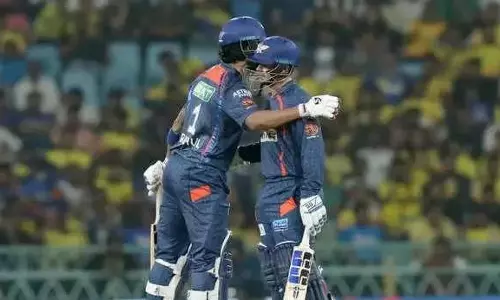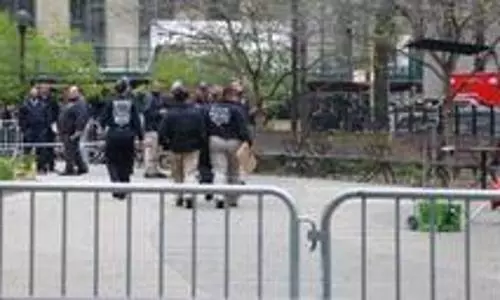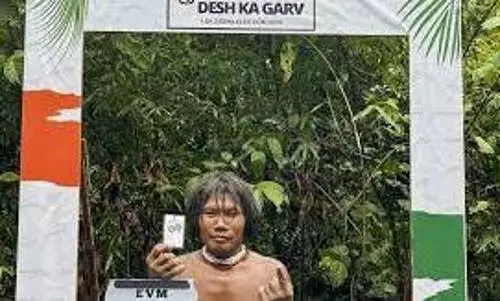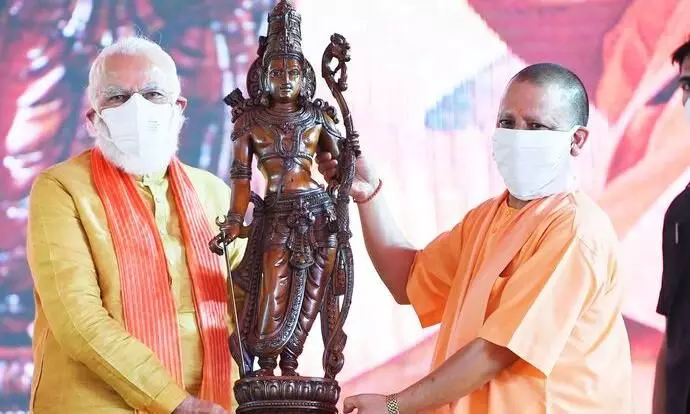
'Jai Shree Ram' to 'Jai Siya Ram' - PM changes tack
text_fieldsImage Courtesy : https://twitter.com/narendramodi
Ayodhya: Apart from sending a wave of jubilation across the length and breadth of the country, 'bhoomi pujan' for the much-debated and much-awaited Ram temple here today also discernable change in the attitude of the top BJP leadership towards Sita who was somehow relegated to the background over the past few decades.
Cries of "Jai Shree Ram" which reverberated at most events of the Bhartiya Janata Party (BJP) or its frontal organisations were ,on Wednesday , replaced with chants of "Jai Siya Ram" And that was led by none other than prime minister Narendra Modi himself, who spent a couple of hours performing the grand ritual for the mega event.
Modi , who was never before heard making reference to Sita , took everyone by surprise when he not only repeatedly talked about "Janki mata" , but also reverted from 'Jai Shree Ram' to the original salutation of 'Siyapati Ram Chandra ki jai'.
'Jai Shree Ram' - which began as a battle cry of the Vishwa Hindu Parishad (VHP)'s war for Ram Janmbhoomi - had clearly overtaken the traditional salutation of 'Siyapati Ram Chandra ki Jai' . And over the years it became common practice particularly with the political leadership to confine themselves essentially to 'Jai Shree Ram', which was also seen as a reflection of the Hindu male chauvinism. "Siyapati" gives precedence to Sita as Ram's identity goes behind as the "husband of Sita".
Many in Ayodhya wonder if it was the end of the struggle for Ram Janmbhoomi , following an order of the Supreme Court, that had prompted Modi to recall the original salutation of 'Siyapati Ram Chandra ki Jai' , with which he negan and concluded his 35-minute address. After all the battle for the temple is now over so why need for a battlecry ?
Whatever it might have been, but the prime minister made it loud and clear to everyone today that he had realized the need for change.The entire focus of his speech after the 'bhoomi pujan' ceremony was towards eulogizing the virtues, greatness and the unparalleled enormity of Ram.
No one knows whether Modi had any purpose behind his own makeover with longer hair and an equally longish beard to match. But there can be no denying that the makeover did go well with the event of the day , when he also donned a golden yellow kurta and off-white 'dhoti' that made him easily merge with the gathering of seers and saints.
Yet, what he skillfully ensured that he and only he remained in the spotlight . Thanks to COVID precautions , he did not have anybody else in close proximity as to share the camera lens focused on him during the entire 'puja' .
While the function was limited largely to sadhus , and every single cabinet colleague of Modi was conspicuous by his absence , RSS chief Mohan Bhagwat remained the most prominent guest at the show . UP Governor Anandibehn Patel and chief minister Yogi Adityanath perhaps remained unavoidable because of protocol reasons.
How systematically all frontline leaders of the Ram temple movement were kept away from the event , was also the loud talk in this ancient temple town. Lal Krishna Advani, Murli Manohar Joshi and Kalyan Singh were not in the guest list at all on the plea of "old age" and the allied risks on account of the pandemic. Even though Uma Bharti was also not invited by the Ram Janmbhoomi Teerth Kshetra Trust managed to use her networking with the 'sant samaj' to get a last minute entry at the 'bhoomi pujan' venue.
A day earlier, Trust general secretary Champat Rai openly declared that none of the above leaders had been invited to the function. Interestingly, each of these leaders were continuing to face criminal charges in a court of law for their alleged involvement in the demolition of the 16th century Babri Masjid on December 6, 1992. Twenty eight years on, the case was yet to reach the final stages .
At the end of the day, it was clearly a Narendra Modi show all the way. He touched down in Ayodhya by a helicopter at precisely 11.30 am and drove through the beautifully decorated and virtually saffron -painted and marigold-bedecked town to reach the steps of the majestic Hanuman Garhi temple , known as the oldest shrine in Ayodhya. Walking up the long flight of steps covered with a red-carpet and flanked by newly painted saffron coloured walls, he first offered prayers before Hanuman's deity (one of the rare Hanuman temples where he is projected as a Raja).
From here the next and final destination was Ram Janmbhoomi , where a very special sprawling 'pandal' awaited him for the grand ritual. Nine 'shilas' (stone bricks) engraved with 'Shree Ram' , were specially lowered in a shallow pit marked by engineers of the construction company Larson and Toubro , as the exact spot where the deity of Ram Lalla was originally installed in 1949 under the central dome of the then Babri Masjid as also after its demolition under the tarpaulin make-shift temple.
The prime minister sought to highlight how the construction of the Ram temple would change the entire dynamics of the otherwise quiet Ayodhya . "The entire region will witness economic development of the kind that none have conceived so far, as it is bound to attract people from across the globe", he said.
While embarking on the vast canvas of Ram,he said, "Ram Sabke hain aur Ram sab mein hain" (Ram is everybodys and he lives in everyone), he gave a long list of countries where Ramayana was a part of their local culture. "Ram's influence is not limited only to different parts of India but it traverses across geographical and political boundaries Malaysia, as also Cambodia, Laos and Thailand ", he pointed out, while adding, "even China, Iran and Sri Lanka had their own stories connected to the Ramayana."
Modi further made it a point to emphasize how Ram's philosophy was aimed at inclusiveness and towards promoting social harmony and universal development and progress. "Ram did not believe in any discrimination with anyone ; and humanity being his cardinal principle he also believed in special compassion for the poor and the weak", he added.
Significantly, he also shunned any remark that could get him the blame of playing politics in the name of the temple. However, whether this is a change that will remain short-lived, only time will tell.


















